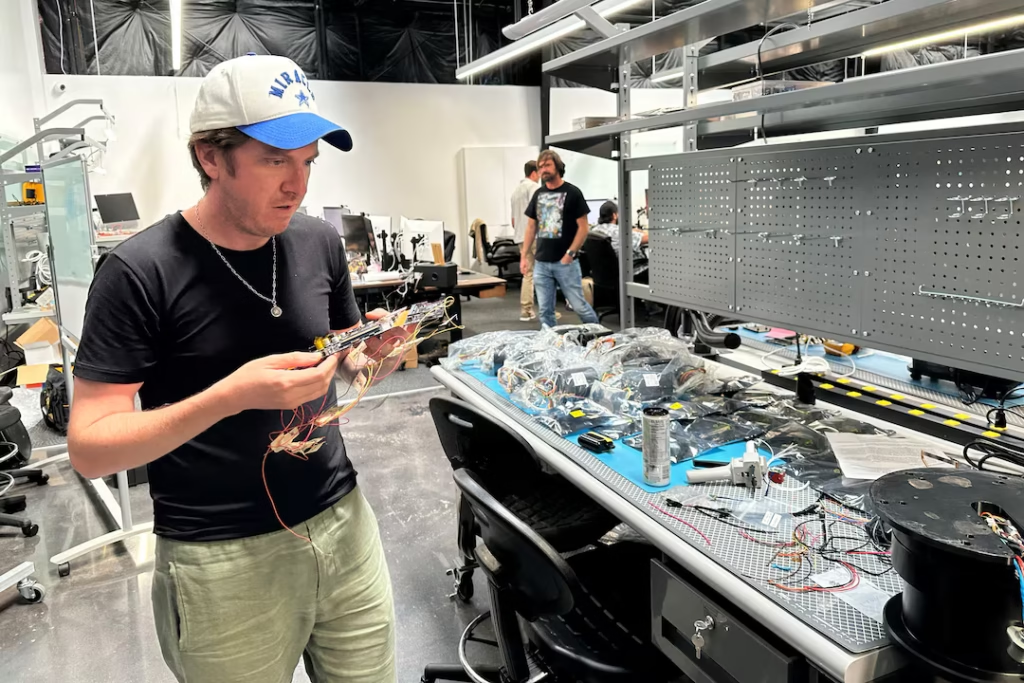NEW YORK (Reuters) — “I’m a warlord now, bitch!”
Steven Simoni, wearing a $4,000 Celine track suit unzipped to reveal a bare chest and a silver chain, was holding court at a recent film premiere in the East Village of Manhattan, joking with a reporter about his latest venture.
The tech entrepreneur was in town to see “Match in a Haystack,” a documentary he funded about a dance troupe that defeats the odds to put on a show in war-torn Ukraine.
A little more than a year ago the 39-year-old was a typical Silicon Valley success story having sold a payments company to DoorDash for $125 million in 2022.
But now he is the co-founder of a different kind of startup, Allen Control Systems, which makes a product far removed from menu QR-codes: an AI-powered autonomous machine gun called the “Bullfrog” designed to shoot drones out of the sky.
“The future is Skynet, basically,” Simoni said, referring to the fictional AI system from the “Terminator” films that becomes self-aware and turns on humanity. “I want to supply those products to the government so they can use them.”
Just a few years ago, the idea that this “Star Wars” nerd and one-time national champion of “A Game of Thrones: The Card Game,” would become a brash defense contractor might have seemed absurd. But Simoni is well on his way, with $40 million in funding – most recently raised in a round led by Craft Ventures, the firm cofounded by President Donald Trump’s AI czar David Sacks – and prototype contracts with the U.S. Army and Special Operations Forces.
Simoni is part of a new generation of entrepreneurs riding Silicon Valley’s pivot to military technologies, as wars in Ukraine and the Middle East, and surging tensions with China, have underscored the U.S. need to prepare for the future of warfare. Using a playbook championed by Anduril founder Palmer Luckey and Palantir CEO Alex Karp, tech entrepreneurs who once sold consumer apps are now developing drone swarms, spy satellites, autonomous boats, and other lethal technologies while raising hype from venture capitalists and the Pentagon alike.
Simoni, a Navy veteran, said his “warlord” character, inspired by Bradley Cooper’s slick arms dealer from the film “War Dogs,” is one ironic way he’s getting attention for his company.
“I hate war, but war is always going to happen anyway,” he said. “So, it’s like, someone’s going to make this product at some point.”
‘The Generals love me’
During a recent dinner in Washington, D.C., with a Reuters reporter, Simoni received a text from a staffer at Executive Branch, the private club founded by Donald Trump Jr. that charges as much as $500,000 to join. The club is happy hunting grounds for an aspiring defense contractor looking to meet people connected to the Trump administration, and Simoni was hoping to negotiate a cut-price entry.
“I should have spent more time on the Executive Branch,” he said, referring to the Trump administration. “The major thing in defense tech is selling to the White House and Congress. Even before the DoD.”
He later opted against joining after learning he wouldn’t get a discount. But his hustle continues to generate outsized attention for his company. He’s appeared on Fox News as a drone expert, launched a podcast featuring interviews with top military officials, and, most recently, joined venture firm Forum Ventures as a partner to invest in other defense tech companies.
Being backed by Sacks’ venture firm has also opened doors, including an invite to a recent AI summit co-hosted by Sacks’ “All-In” podcast where Trump delivered a speech.
He throws late-night parties at the company’s Austin penthouse, attended by startups and government officials alike. Earlier this year, he hosted a fundraiser for Republican congressman John Carter attended by Mike Rogers, the Republican chairman of the House Armed Services Committee. On another occasion, he said he went out for karaoke with military officials he declined to name after a conference. “The generals love me,” he said.
In June, General James Rainey, the commander at Army Futures, the command responsible for modernizing the Army and acquiring cutting-edge technology, joined Simoni on his weekly podcast “The Drone Ultimatum” to discuss the Pentagon’s efforts to work with Silicon Valley.
“It’s really about getting the fiscal agility to go out to the great U.S. tech companies that exist and start buying stuff and get it in the hands of our war fighters,” Rainey said.
In a statement, the U.S. Army said it’s “in the process of awarding a contract to Allen Control Systems,” before the end of the fiscal year to “evaluate the potential for The Bullfrog to integrate into existing Army platforms.”
Carter, Rogers and Sacks did not respond to requests for comment. Craft Ventures declined to comment.
Shooting drones
Allen Control Systems is trying to solve a persistent battlefield danger that has emerged in Ukraine: shooting small, cheap, unjammable drones from the sky before they can attack.
While soldiers currently shoot them with guns, a host of startups have emerged to provide solutions spanning laser beams to microwave blasts. In August, Secretary of Defense Pete Hegseth announced, opens new tab he was launching an anti-drone taskforce to address the issue. “There’s no doubt that the threats we face today from hostile drones grow by the day,” he said.
The company is selling its AI-powered Bullfrog for around $350,000 apiece, making it a potential add-on to autonomous vehicles and unmanned drone boats, or as a stationary sentry to secure perimeters, like the U.S.-Mexico border, or military bases abroad.
The contraption, fit for a scene from the Terminator, can swivel 400 degrees in less than a second. One prototype turret undergoing field testing is called Eminem; another is named Bob, after the late television painter Bob Ross. Under the hood, custom circuit boards feature a printed image of Simoni and co-founder Luke Allen. “If Russia or China recovers one of these eventually, they have to see our faces,” Simoni said. “We’re laughing at them.”
During a demo for the U.S. Army, intelligence community and investors last month at a ranch in Austin, the Bullfrog’s M240 machine gun was mounted on the back of a pickup truck and pelted bullets at drones in the sky. After shooting a burst of about a half dozen rounds, one drone fell from the sky in flames.
Later, the gun jammed, and the drones flew toward the gun before flying away again unscathed.
Simoni shrugged off any concerns, and said the product would be ready for primetime by the end of the year. “It’s in its post-adolescent stage,” Simoni said. “Almost an adult.”
Rack up the hype
Simoni grew up in a military family in Pennsylvania, and joined the Navy as an engineer in 2008 to work on nuclear reactors. There, he met fellow engineer and future co-founder, Luke Allen. After leaving the military, both men moved to Silicon Valley, and – following multiple failed ventures – started the QR code business Bbot in 2019.
The company initially struggled to sell its first product – a robotic system that delivered drinks to tables in restaurants – but found success after pivoting to software. Soon after, it was acquired by DoorDash, minting the founders a small fortune.
“Putin’s second invasion of Ukraine happened within a few days of us selling Bbot,” Allen told Reuters. “So as an engineer, you can basically help the good guys, help the bad guys, or do nothing, which is still a choice.”
Allen left DoorDash and, seeing the growing threat of drones in Ukraine, he started to work on the Bullfrog with seed investment from Simoni. After some convincing, Simoni joined as CEO of Allen Control Systems at the start of 2024. “Every company needs a front man,” Simoni said.
Since then, Simoni has leaned into the Silicon Valley buzz machine. He said Allen sometimes compares him to Elizabeth Holmes, the disgraced founder of health startup Theranos who was convicted of fraud for misrepresenting the capabilities of her blood-testing technology.
“It’s so true because Holmes and I are brilliant marketers, we get people’s attention,” Simoni said. “But (Allen) actually made a real product, and she didn’t have a real product.”
Still, some observers remain cautious of Silicon Valley’s promise to revolutionize the military. “Whether you’re talking about a food startup or defense tech, the idea is to get a prototype out there and try to rack up the hype,” said Roberto Gonzalez, an anthropologist at San Jose State University who studies militarization. “When it comes to defense and weapons systems, the failure could be catastrophic.”
Others in the tech industry remain hostile to the idea of defense contracting. In August, Simoni emailed a prospective software engineer with a plea to join the company. Sheresponded by posting, opens new tab a screenshot of his email on X with the caption: “Imagine having a $125M successful exit and being set for life and then deciding that building ai powered guns is ur life mission [crying face emojis].”
Simoni responded byposting a photo, opens new tab of himself grinning broadly, wearing a T-shirt emblazoned with a screenshot of the woman’s post. “I don’t have to imagine it,” he said.
War Dogs
Earlier this year, Simoni stood down as CEO of Allen Control Systems and became president. The company’s third co-founder and chief operating officer, Mike Wior, who also came from the world of restaurant tech, and previously sold a startup for $50 million, took over as CEO.
“I had a lot more enterprise sales experience,” Wior said. “So the conversations were coming together better for me than they were for Steve.”
But Simoni remains the company’s frontman.
Beyond machine guns, Allen Control Systems has begun testing a prototype laser dazzler, which can damage sensors and video feeds on drones. Simoni said the company is also working on an aerial version of the Bullfrog, called the “Scourge.”
He hopes to take the company public via a SPAC next year, betting that retail investors would swarm to an AI-controlled gun company. “Whenever I go on Fox News,” Simoni said, “my inbox is filled with thousands of messages: What’s the ticker?”
By REUTERS
Reporting by David Jeans; Editing by Joe Brock and Michael Learmonth
Our Standards: The Thomson Reuters Trust Principles.



